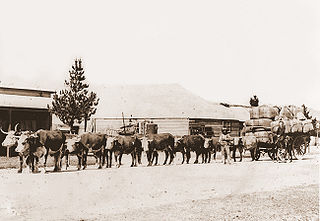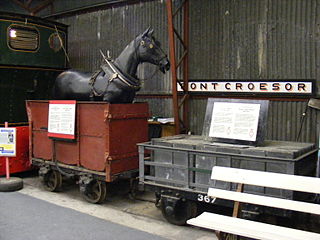
A cart or dray is a vehicle designed for transport, using two wheels and normally pulled by draught animals such as horses, donkeys, mules and oxen, or even smaller animals such as goats or large dogs.

A carriage is a two- or four-wheeled horse-drawn vehicle for passengers. In Europe they were a common mode of transport for the wealthy during the Roman Empire, and then again from around 1600 until they were replaced by the motor car around 1900. They were generally owned by the rich, but second-hand private carriages became common public transport, the equivalent of modern cars used as taxis. Carriage suspensions are by leather strapping or, on those made in recent centuries, steel springs. There are numerous names for different types. Two-wheeled carriages are usually owner-driven.

A wagon is a heavy four-wheeled vehicle pulled by draft animals or on occasion by humans, used for transporting goods, commodities, agricultural materials, supplies and sometimes people.

A buggy refers to a lightweight four-wheeled carriage drawn by a single horse, though occasionally by two. Amish buggies are still regularly in use on the roadways of America. The word "buggy" has become a generic term for "carriage" in America.

Tandem, or in tandem, is an arrangement in which two or more animals, machines, or people are lined up one behind another, all facing in the same direction. Tandem can also be used more generally to refer to any group of persons or objects working together, not necessarily in line.

A phaeton was a form of sporty open carriage popular in the late eighteenth and early nineteenth century. Drawn by one or two horses, a phaeton typically featured a minimal very lightly sprung body atop four extravagantly large wheels. With open seating, it was both fast and dangerous, giving rise to its name, drawn from the mythical Phaëthon, son of Helios, who nearly set the Earth on fire while attempting to drive the chariot of the Sun.

A kalesa, is a two-wheeled horse-drawn carriage used in the Philippines. It is commonly vividly painted and decorated. It was the primary mode of public and private transport in the Philippines during the Spanish and the American colonial period. Their use declined with the increasing use of motorized vehicles in the 20th century, until the kalesas stopped being viable in the 1980s. In modern times, they largely only survive as tourist attractions, such as in Vigan, Ilocos Sur.

A runabout is a car body style popular in the 1910s, based on the horse-drawn runabout carriage.

A chaise, sometimes called shay, is a light two-wheeled carriage for one or two people. It may also have a folding hood. The coachmaker William Felton (1796) considered chaises a family of vehicles which included all two-wheel one-horse vehicles such as gigs and whiskies, whereas a similar carriage pulled by two-horses was considered a curricle.

A working animal is an animal, usually domesticated, that is kept by humans and trained to perform tasks instead of being slaughtered to harvest animal products. Some are used for their physical strength or for transportation, while others are service animals trained to execute certain specialized tasks. They may also be used for milking or herding. Some, at the end of their working lives, may also be used for meat or leather.

A horse-drawn vehicle is a piece of equipment pulled by one or more horses. These vehicles typically have two or four wheels and were used to carry passengers or a load. They were once common worldwide, but they have mostly been replaced by automobiles and other forms of self-propelled transport but are still in use today.

Sprung cart and unsprung cart are terms used mainly in Britain and Australia to denote a utilitarian type of two-wheeled horse-drawn cart, and indicating whether or not springs were used to support the body of the cart.

A dogcart is a two-wheeled horse-drawn vehicle pulled by a single horse in shafts, or driven tandem. With seating for four, it was designed for sporting shooters and their gun dogs, with a louvred box under the driver's seat to contain dogs. It was developed in the early 1800s to afford more seating than the gig, which seats only two. Seating is two back-to-back crosswise seats, an arrangement called dos-à-dos from French. There is a hinged tailboard which lowers slightly and, supported by chains, acts as a footrest for the rear-facing passengers. Some dogcarts had a mechanism to slide the entire body forward or rearward along the shafts to help balance the weight for the horse.

A tonga or tanga is a two-wheeled cart drawn by a single horse. It is used for transportation in the Indian subcontinent. There is a canopy over the body, one seat faces forward for the driver and one passenger, and one seat faces the rear for a second passenger. Some space is available for baggage below the carriage, between the wheels. This space is often used to carry hay for the horses.
The following outline is provided as an overview of and topical guide to transport:

The dandy waggon is a type of railway carriage used to carry horses on gravity trains. They are particularly associated with the narrow gauge Festiniog Railway (FR) in Wales where they were used between 1836 and 1863.

Driving, when applied to horses, ponies, mules, or donkeys, is a broad term for hitching equines to a wagon, carriage, cart, sleigh, or other horse-drawn vehicle by means of a harness and working them in this way. It encompasses a wide range of activities from pleasure driving, to harness racing, to farm work, horse shows, and even international combined driving.

A horse harness is a device that connects a horse to a horse-drawn vehicle or another type of load to pull. There are two main designs of horse harness: (1) the breast collar or breaststrap, and (2) the full collar or collar-and-hames.

A coach is a large, closed, four-wheeled, passenger-carrying vehicle or carriage usually drawn by two or more horses controlled by a coachman, a postilion, or both. A coach has doors in its sides and a front and a back seat inside. The driver has a raised seat in front of the carriage to allow better vision. It is often called a box, box seat, or coach box. There are many types of coaches depending on the vehicle's purpose.

An ekka is a one-horse carriage used in northern India. Ekkas were something like 'traps', and were commonly used as cabs, or private hire vehicles in 19th-century India. They find frequent mention in colonial literature of the period. It is also said that some kind of ekkas were used by people of Indus Valley civilisation.





















